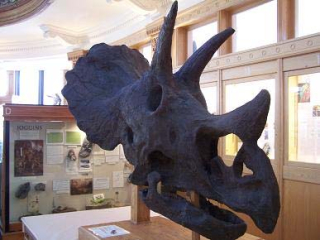
No visit to the Redpath Museum would be complete without seeing the Triceratops skull unearthed in Saskatchewan and painstakingly reconstructed by the Redpath's own palaeontologists.
Nicknamed Sara, this prehistoric herbivore has become a star attraction among the Museum's dinosaur exhibits since she was first introduced to the public in 2008.
Explore the resources below to learn more about Sara's life in the late Cretaceous period and how she came to be rediscovered some 65 million years later.
 Sara – The Biography (PDF)
Sara – The Biography (PDF) Rebuilding a Triceratops (PowerPoint) (slides and audio commentary)
Rebuilding a Triceratops (PowerPoint) (slides and audio commentary) Rebuilding a Triceratops (PDF) (slides only)
Rebuilding a Triceratops (PDF) (slides only)
Meet Sara the Triceratops
Triceratops horridus roamed the earth about 65 million years ago, at the end of the Cretaceous period. The Redpath’s Triceratops cast was created from original skull bones discovered near Eastend, south-western Saskatchewan, and collected by the Redpath Museum under licence from the Royal Saskatchewan Museum.
Although there is no definitive evidence of this Triceratops’ gender, visitors, curators and museum staff have come to know her as Sara. Like others of her kind, Sara was a quadruped (walked on four legs) and a herbivore (plant eater). Sara’s tipped beak allowed her to pluck shorter plants off the ground, and her strong jaw muscles were powerful enough to cut and eat small trees.
The three large horns attached to the skull give the species its name Triceratops, meaning “three-horned face.” Aside from defense, the horns may have been used for attracting a mate as they changed shape and orientation between childhood and adulthood. The equally unmistakable frill at the back of the Triceratops’ head also changed shape and orientation as the animal matured, suggesting it too may have been used to attract a mate.
Image: Mike Chung (Musée Redpath)
Vital statistics
Species: Triceratops horridus
Family: Ceratopsidae
Sub Order: Ceratopsia
Adult length: 9 metres long (30 ft)
Adult weight: 6-12 tonnes
Lived during: Late Cretaceous
Habitat: Triceratops fossils have been found from Alberta to Colorado, and from Saskatchewan to South Dakota.
Diet: Herbivore. Ate plants, possibly small trees.
Behaviour: Lived in packs of hundreds or thousands.

Image; Marmelad. Wikipedia Commons (informations sur la licence incluses)
Sara quick facts
Age at death: Teenager (10 to 15 years old)
Length: Approximately 6 metres
Weight: Approximately 3-5 tonnes
Size of fossil skull: 2m long, 1.35m high, 1.05m wide
Weight of fossil skull: 275 kg. The skull was found broken into 400 pieces. It took three years for the Redpath's palaeontology technician, Chantal Montreuil, to clean, glue and reassemble the skull like a three-dimensional puzzle. There are still lots of pieces missing.
Age of fossil skull: ~ 65 million years old
Discovery: Found by Dr. Hans Larsson and his palaeontology field team in Eastend, southern Saskatchewan (collected under permit from the Royal Saskatchewan Museum).

Image: EOZyo. Wikipedia Commons (informations sur la licence incluses)